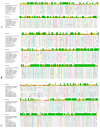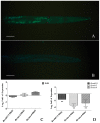Low Temperature Extends the Lifespan of Bursaphelenchus xylophilus through the cGMP Pathway
- PMID: 29099744
- PMCID: PMC5713289
- DOI: 10.3390/ijms18112320
Low Temperature Extends the Lifespan of Bursaphelenchus xylophilus through the cGMP Pathway
Abstract
The causal agent of pine wilt disease, pine wood nematode (PWN) (Bursaphelenchus xylophilus), revealed extended lifespan at low temperature. To discover the molecular mechanism of this phenomenon, we attempted to study the molecular characterization, transcript abundance, and functions of three genes of the cyclic guanosine monophosphate (cGMP) pathway from B. xylophilus. Three cGMP pathway genes were identified from B. xylophilus. Bioinformatic software was utilized to analyze the characteristics of the three putative proteins. Function of the three genes in cold tolerance was studied with RNA interference (RNAi). The results showed that the deduced protein of Bx-DAF-11 has an adenylate and guanylate cyclase catalytic domain, indicating an ability to bind to extracellular ligands and synthesizing cGMP. Both Bx-TAX-2 and Bx-TAX-4 have cyclic nucleotide-binding domains and ion transport protein domains, illustrating that they are cGMP-gated ion channels. The transcript level of Bx-daf-11, Bx-tax-2, and Bx-tax-4 increased at low temperature. The survival rates of three gene silenced B. xylophilus revealed a significant decrease at low temperature. This study illustrated that the cGMP pathway plays a key role in low-temperature-induced lifespan extension in B. xylophilus.
Keywords: Bursaphelenchus xylophilus; cGMP pathway; lifespan extension; low temperature; pine wilt disease.
Conflict of interest statement
The authors declare no conflict of interest.
Figures





Similar articles
-
Cathepsin L-like Cysteine Proteinase Genes Are Associated with the Development and Pathogenicity of Pine Wood Nematode, Bursaphelenchus xylophilus.Int J Mol Sci. 2019 Jan 8;20(1):215. doi: 10.3390/ijms20010215. Int J Mol Sci. 2019. PMID: 30626082 Free PMC article.
-
Silencing of cyp-33C9 Gene Affects the Reproduction and Pathogenicity of the Pine Wood Nematode, Bursaphelenchus xylophilus.Int J Mol Sci. 2019 Sep 12;20(18):4520. doi: 10.3390/ijms20184520. Int J Mol Sci. 2019. PMID: 31547281 Free PMC article.
-
Molecular characterization and functional analysis of multidrug resistance-associated genes of Pinewood nematode (Bursaphelenchus xylophilus) for nematicides.Pestic Biochem Physiol. 2021 Aug;177:104902. doi: 10.1016/j.pestbp.2021.104902. Epub 2021 Jun 12. Pestic Biochem Physiol. 2021. PMID: 34301363
-
Molecular Defense Response of Pine Trees (Pinus spp.) to the Parasitic Nematode Bursaphelenchus xylophilus.Cells. 2022 Oct 13;11(20):3208. doi: 10.3390/cells11203208. Cells. 2022. PMID: 36291077 Free PMC article. Review.
-
Bursaphelenchus xylophilus: opportunities in comparative genomics and molecular host-parasite interactions.Mol Plant Pathol. 2008 May;9(3):357-68. doi: 10.1111/j.1364-3703.2007.00461.x. Mol Plant Pathol. 2008. PMID: 18705876 Free PMC article. Review.
Cited by
-
Whole-Genome Sequences of 13 Chinese Indigenous Pinewood Nematodes, Bursaphelenchus xylophilus.Int J Mol Sci. 2024 Sep 29;25(19):10492. doi: 10.3390/ijms251910492. Int J Mol Sci. 2024. PMID: 39408821 Free PMC article.
-
Transcriptome-Based Analysis Reveals a Crucial Role of BxGPCR17454 in Low Temperature Response of Pine Wood Nematode (Bursaphelenchus xylophilus).Int J Mol Sci. 2019 Jun 14;20(12):2898. doi: 10.3390/ijms20122898. Int J Mol Sci. 2019. PMID: 31197083 Free PMC article.
-
Functional Study on Cytochrome P450 in Response to L(-)-Carvone Stress in Bursaphelenchus xylophilus.Genes (Basel). 2022 Oct 27;13(11):1956. doi: 10.3390/genes13111956. Genes (Basel). 2022. PMID: 36360193 Free PMC article.
-
On the role of dauer in the adaptation of nematodes to a parasitic lifestyle.Parasit Vectors. 2021 Oct 27;14(1):554. doi: 10.1186/s13071-021-04953-6. Parasit Vectors. 2021. PMID: 34706780 Free PMC article. Review.
-
Cytochrome P450 metabolism mediates low-temperature resistance in pinewood nematode.FEBS Open Bio. 2020 Jun;10(6):1171-1179. doi: 10.1002/2211-5463.12871. Epub 2020 May 22. FEBS Open Bio. 2020. PMID: 32348629 Free PMC article.
References
-
- Richardson D.M., Pysek P., Elton C.S. The Ecology of Invasions by Animals and Plants. The University of Chicago Press; Chicago, IL, USA: 2007. pp. 659–666.
-
- Panov V.E., Krylov P.I., Riccardi N. Role of diapause in dispersal and invasion success by aquatic invertebrates. J. Limnol. 2004;63:56–69. doi: 10.4081/jlimnol.2004.s1.56. - DOI
-
- Diaz R., Overholt W.A., Dan H., Samayoa A.C. Diapause Induction in Gratiana boliviana (Coleoptera: Chrysomelidae), a biological control agent of tropical soda apple in Florida. Ann. Entomol. Soc. Am. 2011;104:1319–1326. doi: 10.1603/AN11053. - DOI
MeSH terms
Substances
LinkOut - more resources
Full Text Sources
Other Literature Sources
Miscellaneous

